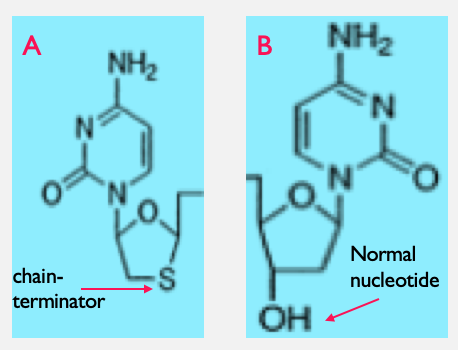The most popular drug that is given to the patients is known as Lamivudine. These drugs act to stop replication by acting as a "chain terminators" during the synthesis of DNA to prevent viral DNA from being copied. The antiviral drugs are chain terminators because instead of containing an OH group, the drugs incorporate a sulfur to stop the strand of DNA from adding another nucleotide(Fig.1). However, the drugs have shown be toxic to the patients because not only is the viral DNA being stopped from synthesizing but also these drugs inhibit replication of regular DNA in human cell mitochondria. The mitochondria is the powerhouse of the cell which takes in nutrients and breaks them down to and make energy rich molecules for the cell. Dr. Feng and her team looked at the mechanism of inhibition of the protein that synthesizes DNA in the mitochondria (mitochondria DNA polymerase) using an enzyme kineticsExperiment to observe the rate of nucleotides being incorporated into the DNA sequence. approach. The approach examined the rate of incorporation of the nucleotide drug compared to a regular nucleotide into DNA by the mitochondrial DNA polymerase. Finding what could be causing the toxicity to the mitochondria may help with the production of newer drugs in the future.
Joy Y. Feng, Allison A. Johnson, Kenneth A. Johnson and Karen S. Anderson(2001)
Insights into the Molecular Mechanism of Mitochondrial Toxicity by
AIDS Drugs*
The Journal of Biological Chemistry Vol.276,No.26, Issue of June, pp.23832-23837
Insights into the Molecular Mechanism of Mitochondrial Toxicity by AIDS Drugs*
The Journal of Biological Chemistry Vol.276,No.26, Issue of June, pp.23832-23837
(Translated by Owais A. Shahzada)
Significance
Human immunodeficiency virus (HIV) is a devasting virus to contract. Almost 36.7 million people have been estimated to be living with HIV around the world in 2016 (citation). During that year almost 1.8million people have become newly infected, and 1 million have died of HIV-related causes. For patients to combat the virus from spreading throughout their system they are required to take antiviral medications, most often for the rest of their lives. Some forms of these antiviral drugs stop viral RNA from being copied (replicated) into DNA because they mimic natural building blocks of DNA.
Contents |

Fig. 1: Chain terminating analog and original nucleotide: The figure is an image of a nucleoside analog(A) and a construction of a normal nucleotide(B). In image A the nucleoside analog contains a Sulfur which disallows the bonding of a new nucleotide to the sequence. Making this a 'chain terminator'.In image B the 'OH'group located at the end allows nucleotides to be added to the growing chain.
|